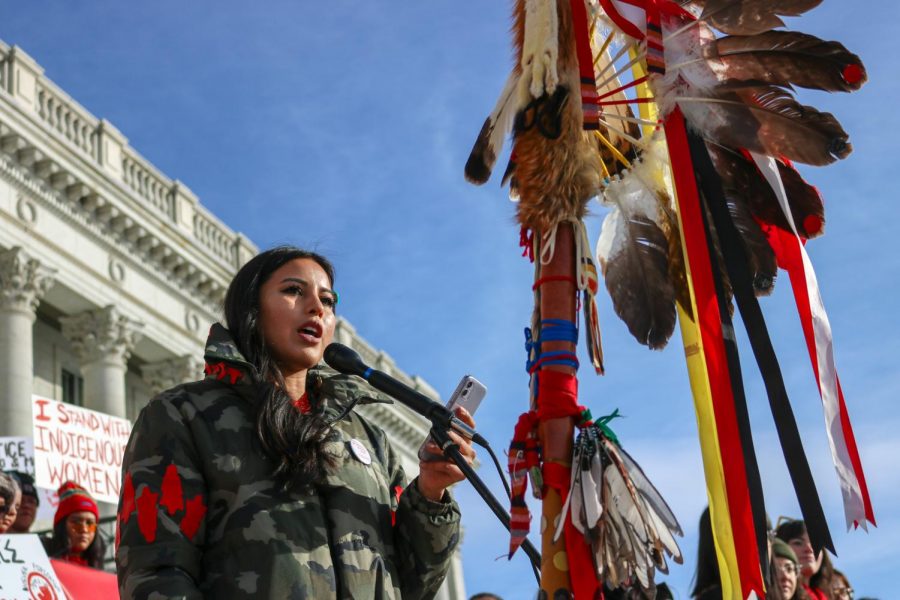Christopherson: The SLC Womxn’s March Was A Great Start, but There’s Work Left to Do
Michelle Brown, campaign chair of the Missing and Murdered Indigenous Women organization, speaks at the Womxn’s March at the Utah state capitol on Saturday, Jan. 18, 2020.
February 13, 2020
On Jan. 18, hundreds of Utahns passed up their weekly opportunity to sleep in in favor of attending what has become the annual Salt Lake City Womxn’s March, and I was lucky — with my mom, two younger sisters and a close friend — to be among them. We bundled up and walked from Washington Square Park to the Utah State Capitol building, waving our handmade posters over our heads and chanting along with like-minded people that “women’s rights are human rights.”
I always love going to these marches. They motivate and inspire me; they help me feel connected to the women in my community. This year’s march was particularly informative and empowering — but it won’t be enough to make Utah a better place for women unless we follow through on the issues the speakers and organizers raised.
First, it’s important to note that the SLC Womxn’s March Committee, who put on the rally, is not affiliated with the national Women’s March organization, for the same reasons they use an “x” in “womxn”: to be inclusive of trans, minority, indigenous, incarcerated and immigrant women, poor women and women with mental health problems and disabilities. Whereas the national group has been criticized for anti-Semitism, our Salt Lake committee, made up of seven women college students, prioritizes intersectionality – and the march reflected that principle. Speakers at the march (which my colleagues at The Daily Utah Chronicle News Desk covered previously) spoke about murdered and missing indigenous women, incarcerated women, the compounded discrimination women of color often experience and how feminism protects non-binary people.
Women in the United States have a long history of marching for change, and, in some ways, it’s a great mechanism for progress. It’s visible, it’s loud, it’s motivating — a great start, in other words. But rallies and protests weren’t enough in the days of the suffragists — Alice Paul went on a hunger strike, Ida B. Wells started the Alpha Suffrage Club of Chicago and countless others organized and lobbied and made sacrifices for the vote — and they’re not enough now.
Part of the problem is that — though the SLC Womxn’s March Committee makes sure this isn’t the case in our capital city — marches often provide a very limited snapshot of the larger feminist movement. In the early 20th century, white suffragists would march for women’s equality while excluding black women or forcing them to march at the back. That same lack of inclusivity permeates women’s marches and “feminist” organizations today.
Even at their most inclusive, though, the marches (which take place all over the country) are insufficient to change practical or legal realities for women. While they’re a good way to get lawmakers’ attention, they don’t achieve anything in terms of holding leaders accountable to make the changes women need and expect to see.
It’s obvious, but worth saying again and again: the most effective way for women to make our voices heard is to vote. Nothing will change unless we do.
That means we need to take voting extremely seriously. Track your representatives’ voting records, research candidates’ platforms thoroughly before you make a decision. And, between now and November, let your senators and representatives know what you want from them — especially during the legislative session, which runs each winter from late January into March. Our local policymakers have a particularly significant impact on our daily lives, with bills like this year’s Abortion Amendments (H.B. 65), Sick Leave Amendments (H.B. 69), and Joint Resolution Ratifying an Amendment to the United States Constitution (H.J.R. 7) — even the Missing and Murdered Indigenous Women, Girls and LGBTQ+ Task Force (H.B. 116) sponsored by Representative Angela Romero. Make sure your elected officials hear from you on bills like these. (You can find out who your federal representatives are here and who your local elected officials are here.)
The legacy of the women’s marches we’ve had in Utah and across the nation over the last four years is not the mere existence of the events themselves — it’s the wave of women elected to public office in 2018 and the surge of women voters the marches prompted. So don’t beat yourself up if you slept in and missed the Salt Lake City march this month, and don’t feel like you’ve done your part if you made it there. The march to the polls 10 months from now — and in March, for the presidential primary election — is what really makes a difference.








